
More three-ring fun from the black-and-white days of the early 1930’s. Disney and Lantz seem to take a time out, while virtually every other studio contributes. Tropes of the genre are beginning to be firmly established and liberally borrowed-from, while a few of the upper-class studios still strive for originality.
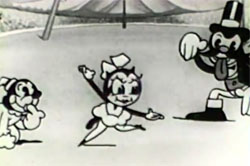 A Circus Romance (Van Bueren/Radio Pictures, Aesop’s Fables, 6/25/32 – John Foster/Harry Bailey, dir.). You’ll recall last week that I said we’d be seeing a parade shot from “Circus Capers” again soon. Well, here it is again, a mere two years later, with the identical music, only substituting an elephant and clown as leaders of the parade instead of the original drim major, but still with the rubbery trombones over-extending to knock them out of the way. It’s not the only shot to be reused from the prior cartoon, as we receive a repeat of the barker spiel that introduced the fat lady, but with the fat lady snipped out of the footage before the crowd enters the tent. (The primitive splice marks where this scene is clipped into the negative are still clearly visible on the print to this day.) In a new parade scene, a small mouse, viewing the marchers passing, retrieves from his house a tuba twice the size of an average instrument, and joins the marchers. He has reason for liking his instruments oversized, as we find a whole orchestra of mice hiding inside the horn’s bell to add to the harmony. As the show begins, a sweet bareback rider ducks out on her own act’s introduction to receive a few kisses from her clown boyfriend. The ringmaster orders her back inside the tent to perform, then tells the clown to “Lay off. She’s mine.” The girl’s horse act is performed without a gag. The clown has a horse act, too, but with a difference. His mount jumps through a series of hoops, each hoop magically changing the steed from one species to another – from horse to lion to pig to kangaroo. The girl ascends a rope to perform a high-wire act, causing the crowd to catch their breath as her balance becomes unsteady. She falls, and the clown ad ringmaster scramble below in attempt to be under her when she lands. But, in what was becoming a common Van Bueren gag (also climaxing the Tom and Jerry short “Trouble”), she miraculously shifts into slow-motion before impact, and gracefully lands on one toe. Despite the tradition of “the show must go on”, the ringmaster chooses this inopportune moment to seize the girl, carrying her to a balloon, and throwing away the anchor to set it aloft. The clown, followed by an elephant, run out of the tent to a teeter-totter. The clown stands on one end, while the elephant jumps on the other, launching the clown high into the air. He overshoots his intended target, but the face of the sun sticks its tongue out, providing the clown with a diving platform, from which he is able to dive back down to the balloon. He battles the ringmaster within the balloon’s basket, then inserts the end of the ballon’s air bag into the ringmaster’s mouth. The ringmaster is quickly filled with hot air, and the clown pushes him away, floating the ringmaster off into the clouds, while the clown and gorl kiss and embrace for the iris out.
A Circus Romance (Van Bueren/Radio Pictures, Aesop’s Fables, 6/25/32 – John Foster/Harry Bailey, dir.). You’ll recall last week that I said we’d be seeing a parade shot from “Circus Capers” again soon. Well, here it is again, a mere two years later, with the identical music, only substituting an elephant and clown as leaders of the parade instead of the original drim major, but still with the rubbery trombones over-extending to knock them out of the way. It’s not the only shot to be reused from the prior cartoon, as we receive a repeat of the barker spiel that introduced the fat lady, but with the fat lady snipped out of the footage before the crowd enters the tent. (The primitive splice marks where this scene is clipped into the negative are still clearly visible on the print to this day.) In a new parade scene, a small mouse, viewing the marchers passing, retrieves from his house a tuba twice the size of an average instrument, and joins the marchers. He has reason for liking his instruments oversized, as we find a whole orchestra of mice hiding inside the horn’s bell to add to the harmony. As the show begins, a sweet bareback rider ducks out on her own act’s introduction to receive a few kisses from her clown boyfriend. The ringmaster orders her back inside the tent to perform, then tells the clown to “Lay off. She’s mine.” The girl’s horse act is performed without a gag. The clown has a horse act, too, but with a difference. His mount jumps through a series of hoops, each hoop magically changing the steed from one species to another – from horse to lion to pig to kangaroo. The girl ascends a rope to perform a high-wire act, causing the crowd to catch their breath as her balance becomes unsteady. She falls, and the clown ad ringmaster scramble below in attempt to be under her when she lands. But, in what was becoming a common Van Bueren gag (also climaxing the Tom and Jerry short “Trouble”), she miraculously shifts into slow-motion before impact, and gracefully lands on one toe. Despite the tradition of “the show must go on”, the ringmaster chooses this inopportune moment to seize the girl, carrying her to a balloon, and throwing away the anchor to set it aloft. The clown, followed by an elephant, run out of the tent to a teeter-totter. The clown stands on one end, while the elephant jumps on the other, launching the clown high into the air. He overshoots his intended target, but the face of the sun sticks its tongue out, providing the clown with a diving platform, from which he is able to dive back down to the balloon. He battles the ringmaster within the balloon’s basket, then inserts the end of the ballon’s air bag into the ringmaster’s mouth. The ringmaster is quickly filled with hot air, and the clown pushes him away, floating the ringmaster off into the clouds, while the clown and gorl kiss and embrace for the iris out.
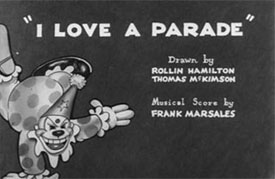 I Love a Parade (Harman-Ising/Warner, Merrie Melodies, 8/6/32) – This is practically Harman and Ising doing an Aesop’s Fable – and exceeding Van Bueren’s quality on practically all levels. It opens with one shot of slightly-repurposed animation, as a clown cavorts for the crowd before the start of the big show, performing tumbles and handstands. An overused camera angle, which was a studio favorite dating back at least to “Lady, Play Your Mandolin” (1931) (or did ot begin in some previous Oswald?) has the clown open his mouth wide with laughter, advancing at the camera so that the lens goes right down his throat, emphasizing the ridges of his upper palate. As with the Aesop above, a parade follows (allowing the crowd to vocalize the featured title number). A marching kangaroo plays trombone, while a Joey in her pouch plays clarinet counterpoint. A lion beats a bass drum carried by a mouse, until one pound too many upon the drum’s fabric busts it. A barking dog happens by, giving the lion an idea. He force-feeds the drum’s framework into the dog’s open mouth, inflating the dog to the dimensions of the drum within – then beats out a rhythm on the dog’s sides as his new “skins”. A clown marches by, carrying a parasol, and further providing his own need for carrying it, with a watering can mounted above the umbrella to provide artificial rain. A dachshund clown supports his midriff on a roller skate, and his rear end on a unicycle. A motorized lion cage aboard a truck bed is driven along by a trainer, as the lion angrily roars inside the cage bars. For no appaent reason, the truck passes through an oversize section of steel pip, and emerges on the other side with the lion driving, and the trainer fuming inside the barred cage. For no further apparent reason, the vehicle is depicted as also towing a small mobile outhouse. Another lion cage presents an act within, with two monkeys playing jump rope with the lion’s tail. As the final bars of the title song conclude, a bird pushing a street-cleaner’s wheeled trash pail questions the crowd’s opinion of the parade, wise cracking “Oh, yeah?”, as he reaches for a jumbo-sized trash scoop, and walks ahead out of frame to take care of an unseen mess left behind the elephants.
I Love a Parade (Harman-Ising/Warner, Merrie Melodies, 8/6/32) – This is practically Harman and Ising doing an Aesop’s Fable – and exceeding Van Bueren’s quality on practically all levels. It opens with one shot of slightly-repurposed animation, as a clown cavorts for the crowd before the start of the big show, performing tumbles and handstands. An overused camera angle, which was a studio favorite dating back at least to “Lady, Play Your Mandolin” (1931) (or did ot begin in some previous Oswald?) has the clown open his mouth wide with laughter, advancing at the camera so that the lens goes right down his throat, emphasizing the ridges of his upper palate. As with the Aesop above, a parade follows (allowing the crowd to vocalize the featured title number). A marching kangaroo plays trombone, while a Joey in her pouch plays clarinet counterpoint. A lion beats a bass drum carried by a mouse, until one pound too many upon the drum’s fabric busts it. A barking dog happens by, giving the lion an idea. He force-feeds the drum’s framework into the dog’s open mouth, inflating the dog to the dimensions of the drum within – then beats out a rhythm on the dog’s sides as his new “skins”. A clown marches by, carrying a parasol, and further providing his own need for carrying it, with a watering can mounted above the umbrella to provide artificial rain. A dachshund clown supports his midriff on a roller skate, and his rear end on a unicycle. A motorized lion cage aboard a truck bed is driven along by a trainer, as the lion angrily roars inside the cage bars. For no appaent reason, the truck passes through an oversize section of steel pip, and emerges on the other side with the lion driving, and the trainer fuming inside the barred cage. For no further apparent reason, the vehicle is depicted as also towing a small mobile outhouse. Another lion cage presents an act within, with two monkeys playing jump rope with the lion’s tail. As the final bars of the title song conclude, a bird pushing a street-cleaner’s wheeled trash pail questions the crowd’s opinion of the parade, wise cracking “Oh, yeah?”, as he reaches for a jumbo-sized trash scoop, and walks ahead out of frame to take care of an unseen mess left behind the elephants.
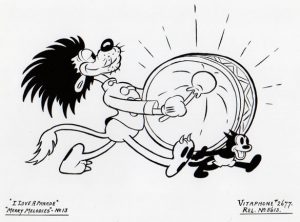 An interlude takes places at the Side Show. A barker introduces an African wild man, then Gumbo, the India rubber man. Gumbo gives a remarkable performance, rolling around on the stage, transforming himself into an automotive tire complete with patch on the side, then curling up into a basketball, allowing the barker to dribble him. A gag is lifted verbatim from Toby the Pup’s “Circus Time”, with Siamese twin pigs, one smoking a cigar and the other exhaling the smoke. A tattooed man puts on a performance, wearing a gruff expression on his real countenance, but bowing his head to reveal a tattooed face of an effeminate man etched on his bald scalp. He flexes his arm muscles, making a tattoo of a shapely female become unsightly and overweight in the rear by the expansion of his bicep. On the same stage to his left, a hippo hula dancer performs a shimmy dance. A small kitten hidden in a soap box platform tickles the dancer with a party blower, causing her to giggle in embarrassment. When she turns around, all she sees is the tattooed man flexing his arm muscle in her direction – and assumes the worst of him. She smacks him down with one blow, and the impact of the punch sinks a sailing ship tattooed on the man’s chest. A “skinny man from India” turns out to be Mahatma Ghandi, performing a snake charmer number on flute. We finally move inside the big tent once again, where Mademoiselle Fifi (a hippo) performs a bareback-riding act with her horse. Her weight, however, is a problem. When she leaps onto the rear end of the horse, it deflates like a flattened balloon. When she tries again, with a leap onto the horse’s back, a dust cloud is produced obliterating the screen, and when the dust clears, the horse is riding atop Fifi’s back instead. A second act has a small mouse circumnavigating a moving elephant by riding laps around his body with a miniature bicycle. A cat performs the same kind of tightrope act as in the Aesop film above, here shown from a camera angle looking down upon the wire and crowd. A funny gag shows us an ostrich outside who has not paid the price of admission, but instead watches the tightrope act by sticking his long neck through a small hole in the side of the tent. His plan has unexpected repercussions, when a group of mice use him as a means of sneaking in themselves. One mouse after another stands upon the ostrich’s back, while another shoots a rock at the ostrich’s rear with a slingshot. Each shot causes the ostrich’s rear to leap painfully into the air, launching the mouse astride him into a gap in the tent seams above them. The ostrich can only briefly pull his head out of the hole, to mutter “Wise guy!” The final act is of lion taming, with perhaps one of the earliest uses of trainer putting his head in the lion’s mouth, then lion putting his head in the trainer’s mouth. Stuck for an ending to the film, the final shot has the lion suddenly develop a bad case of flea infestation (though there is no sign of a flea circus nearby), and after many attempts to reach the itch in his center back, hitting upon the idea to remove his own false teeth, then manipulate them like castanets with his tail to chomp the fleas out of his hair. Despite this weak coda, the film is well-timed for its day, and really seems to show Van Beuren – and many other rivals – a thing or two.
An interlude takes places at the Side Show. A barker introduces an African wild man, then Gumbo, the India rubber man. Gumbo gives a remarkable performance, rolling around on the stage, transforming himself into an automotive tire complete with patch on the side, then curling up into a basketball, allowing the barker to dribble him. A gag is lifted verbatim from Toby the Pup’s “Circus Time”, with Siamese twin pigs, one smoking a cigar and the other exhaling the smoke. A tattooed man puts on a performance, wearing a gruff expression on his real countenance, but bowing his head to reveal a tattooed face of an effeminate man etched on his bald scalp. He flexes his arm muscles, making a tattoo of a shapely female become unsightly and overweight in the rear by the expansion of his bicep. On the same stage to his left, a hippo hula dancer performs a shimmy dance. A small kitten hidden in a soap box platform tickles the dancer with a party blower, causing her to giggle in embarrassment. When she turns around, all she sees is the tattooed man flexing his arm muscle in her direction – and assumes the worst of him. She smacks him down with one blow, and the impact of the punch sinks a sailing ship tattooed on the man’s chest. A “skinny man from India” turns out to be Mahatma Ghandi, performing a snake charmer number on flute. We finally move inside the big tent once again, where Mademoiselle Fifi (a hippo) performs a bareback-riding act with her horse. Her weight, however, is a problem. When she leaps onto the rear end of the horse, it deflates like a flattened balloon. When she tries again, with a leap onto the horse’s back, a dust cloud is produced obliterating the screen, and when the dust clears, the horse is riding atop Fifi’s back instead. A second act has a small mouse circumnavigating a moving elephant by riding laps around his body with a miniature bicycle. A cat performs the same kind of tightrope act as in the Aesop film above, here shown from a camera angle looking down upon the wire and crowd. A funny gag shows us an ostrich outside who has not paid the price of admission, but instead watches the tightrope act by sticking his long neck through a small hole in the side of the tent. His plan has unexpected repercussions, when a group of mice use him as a means of sneaking in themselves. One mouse after another stands upon the ostrich’s back, while another shoots a rock at the ostrich’s rear with a slingshot. Each shot causes the ostrich’s rear to leap painfully into the air, launching the mouse astride him into a gap in the tent seams above them. The ostrich can only briefly pull his head out of the hole, to mutter “Wise guy!” The final act is of lion taming, with perhaps one of the earliest uses of trainer putting his head in the lion’s mouth, then lion putting his head in the trainer’s mouth. Stuck for an ending to the film, the final shot has the lion suddenly develop a bad case of flea infestation (though there is no sign of a flea circus nearby), and after many attempts to reach the itch in his center back, hitting upon the idea to remove his own false teeth, then manipulate them like castanets with his tail to chomp the fleas out of his hair. Despite this weak coda, the film is well-timed for its day, and really seems to show Van Beuren – and many other rivals – a thing or two.
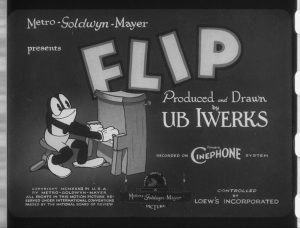 Circus (Ub Iwerks/MGM, Flip the Frog, 9/7/32) – A somewhat disappointing outing for the series, giving the seasoned viewer a sense of “been there, done that”. A montage of shots of a ringmaster and various circus acts and sideshow attractions opens the film – all without gag content. Flip is introduced as a hot dog vendor – in a routine lifted verbatim from two prior Iwerks cartoons – Oswald Rabbit’s “All Wet”, and Mickey Mouse’s “The Karnival Kid.” Flip’s hot dog stand features a small doghouse, from which live hot dogs emerge to be selected (again, a concept Iwerks had stolen from Terry in the first place). The selected dog is instructed to “lay down” on the griddle, then “roll over” to brown the other side. Flip slices open a bun with an electric fan, then has the hot dog apply its own mustard by climbing a spoon to the rim of a mustard jar, sitting to dip its rear end in the tasty spice. The customer receives the finished product, but the still-alive dog howls when bitten into, leaping out of the bun. In this case, there is a different payoff to the routine, as the hot dog lands on the platform of the Siamese twins (two Oriental conjoined humans), one of whom swallows the hot dog, while the other smacks his lips and rubs his tummy in satisfaction.
Circus (Ub Iwerks/MGM, Flip the Frog, 9/7/32) – A somewhat disappointing outing for the series, giving the seasoned viewer a sense of “been there, done that”. A montage of shots of a ringmaster and various circus acts and sideshow attractions opens the film – all without gag content. Flip is introduced as a hot dog vendor – in a routine lifted verbatim from two prior Iwerks cartoons – Oswald Rabbit’s “All Wet”, and Mickey Mouse’s “The Karnival Kid.” Flip’s hot dog stand features a small doghouse, from which live hot dogs emerge to be selected (again, a concept Iwerks had stolen from Terry in the first place). The selected dog is instructed to “lay down” on the griddle, then “roll over” to brown the other side. Flip slices open a bun with an electric fan, then has the hot dog apply its own mustard by climbing a spoon to the rim of a mustard jar, sitting to dip its rear end in the tasty spice. The customer receives the finished product, but the still-alive dog howls when bitten into, leaping out of the bun. In this case, there is a different payoff to the routine, as the hot dog lands on the platform of the Siamese twins (two Oriental conjoined humans), one of whom swallows the hot dog, while the other smacks his lips and rubs his tummy in satisfaction.
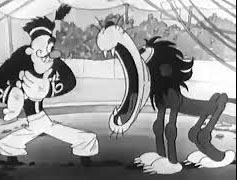 A pickpocket lingers behind members of the crowd, targeting a stereotype “thrifty”-looking Scotsman. Lifting up the Scot’s shirttail, he finds a pants pocket guarded with an iron padlock. Equipped for such emergencies, the pickpocket cracks off the lock with an oversized set of pliers. He retrieves a purse from the man’s pocket, but has to dodge a swarm of moths that fly out when he opens it. Shaking the purse in order to find its meager contents hidden within, the pickpocket finds only two well-used cigar butts, and one penny dated 1492! (I‘d take that penny to a coin collector’s shop – it’s probably worth something.) Instead, the pickpocket throws the contents upon the ground in disgust, and searches out another target. The old crone who regularly appears in Flip cartoons also happens to be within the crowd. In a scene censored from most prints, the pickpocket sizes up the touchy situation, and carefully attempts to reach for the crone’s purse, but pats her rear end instead. She feels it – and likes it, squealing, and thinking the young mam is flirting with her. The pickpocket will have none of this romantic stuff, and grabs for the purse, making off with it. “He’s gone, he’s gone”, shouts the crone. Flip to the rescue, in a prolonged typical chase. The pickpocket mounts a circus horse to make his getaway, but as the steed passes the opening to the circus tent, it turns and goes inside. Flip tries to follow on a mule, but the stubborn creature won’t budge. Flip reaches to a plank to whack the animal in the rear, bit himself receives a kick in the pants from the beast, launching him through the roof of the circus tent, and landing him on the back of the same horse ridden by the pickpocket. Flip and the thief race around and around the torso of the stallion, only to cause their mount to split in two. A clown reveals himself to be within the front half of what is merely a horse costume, and, surprisingly, Flip finds the pickpocket hiding in the other half. The pickpocket makes a run for it, colliding with an elephant. The elephant seizes the man in his trunk, tossing him upwards, where he lands on a trapeze platform. Flip attempts to follow, trying to climb the nearest hanging rope. But the “rope” is really a living snake, which falls to the ground, then shapes itself like a hoop to roll away. Flip finds a more sturdy means of climbing, scrambling up the back of a giraffe. The pickpocket grabs a trapeze in attempt to swing to the other side of the tent, but miscalculates his swing, not quite reaching the opposite platform. He swings back toward Flip, who grabs onto him by the ankles. The pickpocket tries to shake Flip loose, but Flip counters by taking a bite upon the man’s leg. Flip ultimately falls, onto one end of a teeter-totter, on the other end of which is standing the old crone. In a well-animated tracking shot, the crone is rocketed upwards, intercepting the arms of a performing troupe of trapeze artists. She is swing from performer to performer, in the process losing her skirt and bloomers. She is tossed back to earth, sliding down the back of an ostrich. As she passes, she scalps off and picks up the plumage of the bird, which collects around her waist in the shape of a ballet tutu. Both embarrassed and inspired, the crone exits the shot by effeminately toe-dancing, while the more-humiliated ostrich buries its head in the sand.
A pickpocket lingers behind members of the crowd, targeting a stereotype “thrifty”-looking Scotsman. Lifting up the Scot’s shirttail, he finds a pants pocket guarded with an iron padlock. Equipped for such emergencies, the pickpocket cracks off the lock with an oversized set of pliers. He retrieves a purse from the man’s pocket, but has to dodge a swarm of moths that fly out when he opens it. Shaking the purse in order to find its meager contents hidden within, the pickpocket finds only two well-used cigar butts, and one penny dated 1492! (I‘d take that penny to a coin collector’s shop – it’s probably worth something.) Instead, the pickpocket throws the contents upon the ground in disgust, and searches out another target. The old crone who regularly appears in Flip cartoons also happens to be within the crowd. In a scene censored from most prints, the pickpocket sizes up the touchy situation, and carefully attempts to reach for the crone’s purse, but pats her rear end instead. She feels it – and likes it, squealing, and thinking the young mam is flirting with her. The pickpocket will have none of this romantic stuff, and grabs for the purse, making off with it. “He’s gone, he’s gone”, shouts the crone. Flip to the rescue, in a prolonged typical chase. The pickpocket mounts a circus horse to make his getaway, but as the steed passes the opening to the circus tent, it turns and goes inside. Flip tries to follow on a mule, but the stubborn creature won’t budge. Flip reaches to a plank to whack the animal in the rear, bit himself receives a kick in the pants from the beast, launching him through the roof of the circus tent, and landing him on the back of the same horse ridden by the pickpocket. Flip and the thief race around and around the torso of the stallion, only to cause their mount to split in two. A clown reveals himself to be within the front half of what is merely a horse costume, and, surprisingly, Flip finds the pickpocket hiding in the other half. The pickpocket makes a run for it, colliding with an elephant. The elephant seizes the man in his trunk, tossing him upwards, where he lands on a trapeze platform. Flip attempts to follow, trying to climb the nearest hanging rope. But the “rope” is really a living snake, which falls to the ground, then shapes itself like a hoop to roll away. Flip finds a more sturdy means of climbing, scrambling up the back of a giraffe. The pickpocket grabs a trapeze in attempt to swing to the other side of the tent, but miscalculates his swing, not quite reaching the opposite platform. He swings back toward Flip, who grabs onto him by the ankles. The pickpocket tries to shake Flip loose, but Flip counters by taking a bite upon the man’s leg. Flip ultimately falls, onto one end of a teeter-totter, on the other end of which is standing the old crone. In a well-animated tracking shot, the crone is rocketed upwards, intercepting the arms of a performing troupe of trapeze artists. She is swing from performer to performer, in the process losing her skirt and bloomers. She is tossed back to earth, sliding down the back of an ostrich. As she passes, she scalps off and picks up the plumage of the bird, which collects around her waist in the shape of a ballet tutu. Both embarrassed and inspired, the crone exits the shot by effeminately toe-dancing, while the more-humiliated ostrich buries its head in the sand.
The pickpocket finds a motorcycle at the top of a large ramp, just as Flip catches up with him again. The two take off astride the motorcycle, riding through a loop-de-loop on the ramp, and also picking up the crone below on the handlebars. They collide with a number of circus acts, knocking an elephant onto the strong man, and pushing a lion tamer with his head already in a lion’s mouth all the way inside, providing the lion with a tasty early dinner. Our three protagonists crash through the side of the circus tent, and into Flip’s hot dog stand, where they come to a halt. Flip retrieves the purse, and hands it back to the old crone. The crone, however, has no real interest in the purse – it was the man she was after, still smitten from his “flirtation”. The film ends with her pursuing the pickpocket over the horizon, while Flip simply returns to vending his hot dogs, for the iris out.
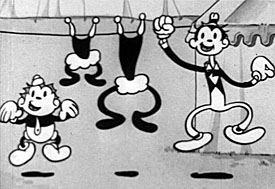 Tight Rope Tricks (Van Beuren/RKO, Tom and Jerry, 1/6/33) ‘ Get ready for it – the same parade from Circus Capers, for the third time in three years! Also, some reused animation of the barker and the fat lady, though not repeating entire shots. Tom and Jerry are substituted as leaders of the parade, oddly still wearing their street clothes, so at first, we are not certain if they are part of the traveling troupe. They engage in attempting to solve the old watering-the-elephants dilemma by the tried-and-true method of hooking the elephant’s trunk to the water pipe, leaving him to fill. A lion keeper approaches the lions’ cage, carrying a huge juicy steak on a pole. As the keeper attends to refilling the lion’s water supply, Tom and Jerry swipe the steak, splitting it among themselves. The keeper never figures out where the steak disappeared, but the lion spots the thieves, and shakes his fist, swearing revenge. Tom and Jerry now change into respective sets of tights, ready to make their appearance as circus acrobats/trapeze artists. After some vigorous tumbling, Tom takes to the trapeze platform, riding down an inclined wire by clinging to the underside of a wheel and handle hooked around the wire with his teeth. As he rolls down the long wire, Tom fastens a small American flag to his posterior for visual flair. Jerry launches himself up to Tom with a teeter-totter and 500 pound weight, but in grabbing Tom’s ankles, loosens Tom’s bite on the handle (because as usual, his teeth are false). Two roustabouts attempt to place a hoop net under the falling boys, but it is only a clown’s paper hoop, through which the boys fall right through. The next act goes on above, as a female tightrope walker (seemingly voiced by one of the same girls who occasionally provided substitute voicing for Betty Boop) performs the number “I’ll Get By (With a Twinkle In by Eye)” Tom and Jerry join the act, stepping out onto the tightrope, with Jerry carrying an upright piano, and Tom riding close behind on a unicycle-piano stool to play musical accompaniment for the girl. (This bit was likely remembered by Famous Studios over a decade later, who had Popeye perform a similar feat in “Tops in the Big Top”.) At the same time, the lion act is going on in another ring of the circus below, with the usual borrowed gag of lion and tamer each inserting their heads in each other’s mouths. The lion looks up, recognizes T&J, and remembers their theft of his dinner. He climbs the tent pole for revenge. Stepping out onto the high wire, the lion shakes the wire violently, putting Tom and Jerry through trembles as they precariously try to maintain their balance. Then the lion pulls out a pair of clipping shears, and cuts the wire. The boys fall, but the lion forgets he is also standing on the same wire, and after a moment’s hesitation falls too. All land in a heap in the center of the arena. The lion rises, calling for assistance from his brothers in other cages, with the old carnival call, “Hey, Rube!” All the other lions of the show burst through the bars of their cages, and are soon chasing our heroes round and round the tent and outside. T&J encounter the elephant they left hooked to the water pipe, now bulging with internal H2O. Unhooking his trunk from the pipe, the boys use the elephant as a high-pressure hose, blasting away line upon line of the pursuing lions, and letting loose so much water, the circus grounds become completely flooded. As the lions go down for the third time, up pops from the waves the elephant, now normal size, upon which ride the girl, the piano, and Tom and Jerry, who play and dance the “I’ll Get By” number for the iris out.
Tight Rope Tricks (Van Beuren/RKO, Tom and Jerry, 1/6/33) ‘ Get ready for it – the same parade from Circus Capers, for the third time in three years! Also, some reused animation of the barker and the fat lady, though not repeating entire shots. Tom and Jerry are substituted as leaders of the parade, oddly still wearing their street clothes, so at first, we are not certain if they are part of the traveling troupe. They engage in attempting to solve the old watering-the-elephants dilemma by the tried-and-true method of hooking the elephant’s trunk to the water pipe, leaving him to fill. A lion keeper approaches the lions’ cage, carrying a huge juicy steak on a pole. As the keeper attends to refilling the lion’s water supply, Tom and Jerry swipe the steak, splitting it among themselves. The keeper never figures out where the steak disappeared, but the lion spots the thieves, and shakes his fist, swearing revenge. Tom and Jerry now change into respective sets of tights, ready to make their appearance as circus acrobats/trapeze artists. After some vigorous tumbling, Tom takes to the trapeze platform, riding down an inclined wire by clinging to the underside of a wheel and handle hooked around the wire with his teeth. As he rolls down the long wire, Tom fastens a small American flag to his posterior for visual flair. Jerry launches himself up to Tom with a teeter-totter and 500 pound weight, but in grabbing Tom’s ankles, loosens Tom’s bite on the handle (because as usual, his teeth are false). Two roustabouts attempt to place a hoop net under the falling boys, but it is only a clown’s paper hoop, through which the boys fall right through. The next act goes on above, as a female tightrope walker (seemingly voiced by one of the same girls who occasionally provided substitute voicing for Betty Boop) performs the number “I’ll Get By (With a Twinkle In by Eye)” Tom and Jerry join the act, stepping out onto the tightrope, with Jerry carrying an upright piano, and Tom riding close behind on a unicycle-piano stool to play musical accompaniment for the girl. (This bit was likely remembered by Famous Studios over a decade later, who had Popeye perform a similar feat in “Tops in the Big Top”.) At the same time, the lion act is going on in another ring of the circus below, with the usual borrowed gag of lion and tamer each inserting their heads in each other’s mouths. The lion looks up, recognizes T&J, and remembers their theft of his dinner. He climbs the tent pole for revenge. Stepping out onto the high wire, the lion shakes the wire violently, putting Tom and Jerry through trembles as they precariously try to maintain their balance. Then the lion pulls out a pair of clipping shears, and cuts the wire. The boys fall, but the lion forgets he is also standing on the same wire, and after a moment’s hesitation falls too. All land in a heap in the center of the arena. The lion rises, calling for assistance from his brothers in other cages, with the old carnival call, “Hey, Rube!” All the other lions of the show burst through the bars of their cages, and are soon chasing our heroes round and round the tent and outside. T&J encounter the elephant they left hooked to the water pipe, now bulging with internal H2O. Unhooking his trunk from the pipe, the boys use the elephant as a high-pressure hose, blasting away line upon line of the pursuing lions, and letting loose so much water, the circus grounds become completely flooded. As the lions go down for the third time, up pops from the waves the elephant, now normal size, upon which ride the girl, the piano, and Tom and Jerry, who play and dance the “I’ll Get By” number for the iris out.
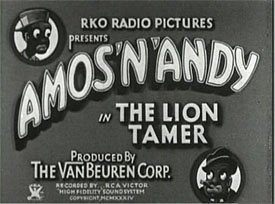 The Lion Tamer (Van Beuren/RKO, Amos ‘n’ Andy, 2/2/34 – George Stallings, dir.) – Only two Amos ‘n’ Andy cartoons were produced, starring the series‘ creators, Freeman Gosden and Charles Correll. Do not be fooled by the spoken introduction provided by the show’s radio announcer – this is their second cartoon, though the announcer indicates it is their first – Van Beuren merely carelessly used the same vocal track on both cartoons. Along with the relatively primitive quality of the animation, it may perhaps have been the writers’ lack of ability to find plausible cartoony situations for the characters to play within that led to the series’ quick demise. A legitimate explanation for the plot setup was lacking in both episodes. In their first instalment, Kingfish has somehow gotten Andy booked into a heavyweight wrestling match for the world championship. How, with Andy having no experience, and no history of winning preliminary bouts? In this episode, Kingfish has elected Andy to be a lion tamer at a carnival. Why? Is the Mystic Knights of the Sea putting on a charity event? What reward is Kingfish attempting to receive for providing a tamer? Despite each cartoon being longer than a normal episode for the studio, no one takes the time to provide the answers to these questions, so our hero/chump Andy is simply cast into a perilous position for no certain reason. I suppose if the series had kept up, we would have seen them rocketing into space, spending the night in a haunted house, or facing other perils in the manner of Tom and Jerry, with no good explanation why these real-life style characters would volunteer for such situations.
The Lion Tamer (Van Beuren/RKO, Amos ‘n’ Andy, 2/2/34 – George Stallings, dir.) – Only two Amos ‘n’ Andy cartoons were produced, starring the series‘ creators, Freeman Gosden and Charles Correll. Do not be fooled by the spoken introduction provided by the show’s radio announcer – this is their second cartoon, though the announcer indicates it is their first – Van Beuren merely carelessly used the same vocal track on both cartoons. Along with the relatively primitive quality of the animation, it may perhaps have been the writers’ lack of ability to find plausible cartoony situations for the characters to play within that led to the series’ quick demise. A legitimate explanation for the plot setup was lacking in both episodes. In their first instalment, Kingfish has somehow gotten Andy booked into a heavyweight wrestling match for the world championship. How, with Andy having no experience, and no history of winning preliminary bouts? In this episode, Kingfish has elected Andy to be a lion tamer at a carnival. Why? Is the Mystic Knights of the Sea putting on a charity event? What reward is Kingfish attempting to receive for providing a tamer? Despite each cartoon being longer than a normal episode for the studio, no one takes the time to provide the answers to these questions, so our hero/chump Andy is simply cast into a perilous position for no certain reason. I suppose if the series had kept up, we would have seen them rocketing into space, spending the night in a haunted house, or facing other perils in the manner of Tom and Jerry, with no good explanation why these real-life style characters would volunteer for such situations.
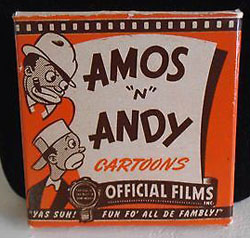 Andy does not take positively to the surprise revelation that he is to perform a lion-taming act at the carnival, until Kingfish informs him that the lion he will tame is merely Brothers Crawford and Lightning in a lion suit. That makes things different with Andy, who looks forward to showing off with a fancy suit and whip in front of Madame Queen. When they arrive at the carnival grounds, Kingfish informs them that there is a real lion about, merely for the people to look at, but assures them that only the fake lion will be with Andy in the cage. Amos and Andy of course wander into the wrong tent, encountering the real lion instead of the fake before the performance, and anger him, with Andy almost getting seized in the lion’s claws. Amos and Andy wheel a cage out of the tent to bring to where the fake lion suit is being donned by the lodge brothers, but the real lion is determined to follow, and begins chomping on the thick rope binding him to a stake in the ground. In the other tent, Andy knows he’s got the right “lion” for his act, when he sees Lightning and Crawford stumbling about in the lion suit, out of step with one another. The cage is wheeled out before the crowd, and Andy enters it, cracking his whip and making the fake lion jump in ways that leave his rear end being carried in the arms of his front end. Meanwhile, the real lion devours the last strands of his rope, and is free. A flip by the brothers in the lion suit causes a trap door ramp in the bottom of the cage to fly open, just as the real lion approaches the cage from below. The brothers take one look at the real big cat, and hotfoot it for the hills, while the real lion mounts the ramp into the cage. A predictable reality-check hits Andy, as he attempts to perform the put-his-head-in-the-lion’s-mouth bit, but finds a powerful roar and teeth inside instead of the face of Brother Crawford. The usual chasing and clawing goes on inside the cage, until Amos opens the cage door long enough for Andy to escape, then shuts it on the lion. As the dust clears inside the cage, we see the lion, smoking Andy’s cigar and cracking Andy’s whip, now taking on the bravado of a human tamer, while Amos merely collapses into his usual reaction of wonderment, “Awaa, Awaa, Awaa”..
Andy does not take positively to the surprise revelation that he is to perform a lion-taming act at the carnival, until Kingfish informs him that the lion he will tame is merely Brothers Crawford and Lightning in a lion suit. That makes things different with Andy, who looks forward to showing off with a fancy suit and whip in front of Madame Queen. When they arrive at the carnival grounds, Kingfish informs them that there is a real lion about, merely for the people to look at, but assures them that only the fake lion will be with Andy in the cage. Amos and Andy of course wander into the wrong tent, encountering the real lion instead of the fake before the performance, and anger him, with Andy almost getting seized in the lion’s claws. Amos and Andy wheel a cage out of the tent to bring to where the fake lion suit is being donned by the lodge brothers, but the real lion is determined to follow, and begins chomping on the thick rope binding him to a stake in the ground. In the other tent, Andy knows he’s got the right “lion” for his act, when he sees Lightning and Crawford stumbling about in the lion suit, out of step with one another. The cage is wheeled out before the crowd, and Andy enters it, cracking his whip and making the fake lion jump in ways that leave his rear end being carried in the arms of his front end. Meanwhile, the real lion devours the last strands of his rope, and is free. A flip by the brothers in the lion suit causes a trap door ramp in the bottom of the cage to fly open, just as the real lion approaches the cage from below. The brothers take one look at the real big cat, and hotfoot it for the hills, while the real lion mounts the ramp into the cage. A predictable reality-check hits Andy, as he attempts to perform the put-his-head-in-the-lion’s-mouth bit, but finds a powerful roar and teeth inside instead of the face of Brother Crawford. The usual chasing and clawing goes on inside the cage, until Amos opens the cage door long enough for Andy to escape, then shuts it on the lion. As the dust clears inside the cage, we see the lion, smoking Andy’s cigar and cracking Andy’s whip, now taking on the bravado of a human tamer, while Amos merely collapses into his usual reaction of wonderment, “Awaa, Awaa, Awaa”..
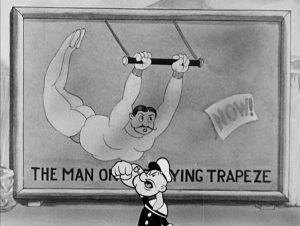 The Man On the Flying Trapeze (Fleischer/Paramount, Popeye 3/16/34 – Dave Fleischer, dir., Willard Bowsky/David Tendlar, anim.) – Popeye, at the helm of a four-smokestack steamship, is so anxious to visit his sweetie Olive Oyl, he drives the ship up onto land and right down the middle of a city street, dropping anchor outside Olive’s front door. The door is answered by Olive’s mother, Nana Oyl, in what may be her only animated appearance. She informs Popeye that Olive left one morning without warning, with the Man on the Flying Trapeze. Dialogue of the film for several minutes follows the lyric of the popular melodrama-song of the same title, which was currently a good seller on record, as discussed in “Needle Drop Notes” columns of James Parten on this site regarding the Fleischer cartoons. Popeye encounters three kids who are his fans, eyeing a circus poster advertising the trapeze act of the same performer (for once, not Bluto). Popeye socks the image of the trapeze man, punching a hole through the poster and fence, through which he and the kids enter to see the show for free. They spot Olive high atop a small platform, in the act with the trapeze man, waiting for her cue to leap out to join him. She complains between the trapeze man’s musical boasts of his prowess, “Don’t try to fool them. You’re just a big cheese”, obviously disinfatuated with her choice in partners and career moves. Spotting Popeye below, she waves to him, but Popeye and the boys turn a cold shoulder to her. The act begins, and Olive has good reason to be fed up with her situation, as she is tossed around like a prop, clung to while suspended between ropes as if a human trapeze bar, and generally manhandled while her partner receives all the applause. Popeye, partly for spite at having his girl taken away, and to a lesser degree in reaction to the mishandling of Olive, mounts the tent pole, climbing up to confront his rival. The battle which ensues is well choreographed, with many tracking shots, dimensional camera angles, and extreme long shots giving a broad sense of dimension of both the expanse of the tent and the great distance of the act above ground level. Olive is comically put through a human version of “the rack”, as the two combatants grab hold of her hands and feet, respectively, then swing on their trapezes in opposite directions, stretching Olive’s limbs to the limit. Olive becomes suspended by her long legs, caught in two rings supported by ropes from the ceiling with no metal bar between them. The boys continue to battle it out, swinging close to each other on respective trapezes, then with precision letting go of the trapeze bars just long enough to exchange punches in mid-air. Popeye receives a blow, sailing him to the next trapeze, where he hangs by his chin. Time for the spinach. Popeye’s attack knocks the trapeze man across seven consecutive trapezes, then upwards into the canvas top of the tent, where he twists into knots, and transforms into the shape of a hanging chandelier. Popeye descends to the ground, then calls out for Olive to jump into his arms. Olive leaps into the air, sailing down, down, just as the three boys circle around Popeye to congratulate him. Popeye lowers his arms to shake their hands, ignoring Olive, who rebounds off the ground before being caught on Popeye’s shoulder. Olive, with a blackened eye and battered form, wobbles, the worse for wear, while Popeye finishes his song, then coldly blows the smoke rings from his pipe into Olive’s face for the fade out.
The Man On the Flying Trapeze (Fleischer/Paramount, Popeye 3/16/34 – Dave Fleischer, dir., Willard Bowsky/David Tendlar, anim.) – Popeye, at the helm of a four-smokestack steamship, is so anxious to visit his sweetie Olive Oyl, he drives the ship up onto land and right down the middle of a city street, dropping anchor outside Olive’s front door. The door is answered by Olive’s mother, Nana Oyl, in what may be her only animated appearance. She informs Popeye that Olive left one morning without warning, with the Man on the Flying Trapeze. Dialogue of the film for several minutes follows the lyric of the popular melodrama-song of the same title, which was currently a good seller on record, as discussed in “Needle Drop Notes” columns of James Parten on this site regarding the Fleischer cartoons. Popeye encounters three kids who are his fans, eyeing a circus poster advertising the trapeze act of the same performer (for once, not Bluto). Popeye socks the image of the trapeze man, punching a hole through the poster and fence, through which he and the kids enter to see the show for free. They spot Olive high atop a small platform, in the act with the trapeze man, waiting for her cue to leap out to join him. She complains between the trapeze man’s musical boasts of his prowess, “Don’t try to fool them. You’re just a big cheese”, obviously disinfatuated with her choice in partners and career moves. Spotting Popeye below, she waves to him, but Popeye and the boys turn a cold shoulder to her. The act begins, and Olive has good reason to be fed up with her situation, as she is tossed around like a prop, clung to while suspended between ropes as if a human trapeze bar, and generally manhandled while her partner receives all the applause. Popeye, partly for spite at having his girl taken away, and to a lesser degree in reaction to the mishandling of Olive, mounts the tent pole, climbing up to confront his rival. The battle which ensues is well choreographed, with many tracking shots, dimensional camera angles, and extreme long shots giving a broad sense of dimension of both the expanse of the tent and the great distance of the act above ground level. Olive is comically put through a human version of “the rack”, as the two combatants grab hold of her hands and feet, respectively, then swing on their trapezes in opposite directions, stretching Olive’s limbs to the limit. Olive becomes suspended by her long legs, caught in two rings supported by ropes from the ceiling with no metal bar between them. The boys continue to battle it out, swinging close to each other on respective trapezes, then with precision letting go of the trapeze bars just long enough to exchange punches in mid-air. Popeye receives a blow, sailing him to the next trapeze, where he hangs by his chin. Time for the spinach. Popeye’s attack knocks the trapeze man across seven consecutive trapezes, then upwards into the canvas top of the tent, where he twists into knots, and transforms into the shape of a hanging chandelier. Popeye descends to the ground, then calls out for Olive to jump into his arms. Olive leaps into the air, sailing down, down, just as the three boys circle around Popeye to congratulate him. Popeye lowers his arms to shake their hands, ignoring Olive, who rebounds off the ground before being caught on Popeye’s shoulder. Olive, with a blackened eye and battered form, wobbles, the worse for wear, while Popeye finishes his song, then coldly blows the smoke rings from his pipe into Olive’s face for the fade out.
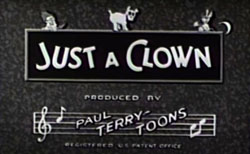 Just a Clown (Terrytoons/Educational, 4/20/34) – We begin with a typical circus parade, a bit sparce on gag content. An opening gag seems to be a reworking of one from “Betty Boop’s Crazy Inventions”, featuring a calliope played by a skinny fellow who seems to be a dead ringer for Terry’s “city slicker” character in the old Farmer Al Falfa cartoons. The music, however, is not the result of steam, or even the keyboard pressing of the skinny man, but instead provided by four yowling cats, their bodies encased inside the calliope’s steel pipes. A lion pedals himself around in an odd conveyance – a cage with a hole cut in the bottom, allowing him a place to sit atop a bicycle mounted below the cage. (Odd that he has to stay in a cage at all, as he is followed by four more lions who roam without enclosure, holding onto each other’s tails in the manner usually reserved for elephants.) A well-drawn perspective shot shows the parade wending its way past the crowd into the big top. As the show begins, the skinny calliope player is introduced as “Danny and his lions”. It is the same act which closed “I Love a Parade”, with a slight twist. After tamer puts his head in the lion’s mouth, the lion not only puts his head in the tamer’s mouth, but marches all the way inside, and is briefly swallowed. Mademoiselle Diveoffskym a hippo, also duplicates at act from a rival cartoon, lifting from “Boop-Oop-a-Doop” the routine if holding onto a trapeze bar with her teeth, then having her dentures come loose. There is again, however, a slight twist. The Mademoiselle here lands safely in a large tank of water, then looks up at her dentures on the trapeze bar. The dentures on cue let go of the trapeze, performing a dive down to the same tank of water, where they are neatly caught in the mouth of the hippo, allowing her to take a smiling bow to the crowd.
Just a Clown (Terrytoons/Educational, 4/20/34) – We begin with a typical circus parade, a bit sparce on gag content. An opening gag seems to be a reworking of one from “Betty Boop’s Crazy Inventions”, featuring a calliope played by a skinny fellow who seems to be a dead ringer for Terry’s “city slicker” character in the old Farmer Al Falfa cartoons. The music, however, is not the result of steam, or even the keyboard pressing of the skinny man, but instead provided by four yowling cats, their bodies encased inside the calliope’s steel pipes. A lion pedals himself around in an odd conveyance – a cage with a hole cut in the bottom, allowing him a place to sit atop a bicycle mounted below the cage. (Odd that he has to stay in a cage at all, as he is followed by four more lions who roam without enclosure, holding onto each other’s tails in the manner usually reserved for elephants.) A well-drawn perspective shot shows the parade wending its way past the crowd into the big top. As the show begins, the skinny calliope player is introduced as “Danny and his lions”. It is the same act which closed “I Love a Parade”, with a slight twist. After tamer puts his head in the lion’s mouth, the lion not only puts his head in the tamer’s mouth, but marches all the way inside, and is briefly swallowed. Mademoiselle Diveoffskym a hippo, also duplicates at act from a rival cartoon, lifting from “Boop-Oop-a-Doop” the routine if holding onto a trapeze bar with her teeth, then having her dentures come loose. There is again, however, a slight twist. The Mademoiselle here lands safely in a large tank of water, then looks up at her dentures on the trapeze bar. The dentures on cue let go of the trapeze, performing a dive down to the same tank of water, where they are neatly caught in the mouth of the hippo, allowing her to take a smiling bow to the crowd.
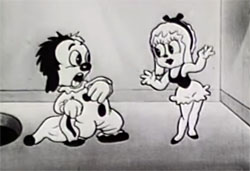 Inside a dressing tent, a clown (played by a white pup with one black ear who was a recurring character at this time, seemingly the ancestor of Puddy, but speaking and acting like a human) begs and implores why his would-be girlfriend (here identified by name as Jenny, though rarely if at all referred to by name in other cartoons) continues to ignore his affections for her. The girl, a bareback rider pup, barely pays attention to him as she powders her nose, then tells him that romance can never be, because he is just a lowly clown. The ringmaster’s whistle calls her to the tent to perform, her act played straight with no gag material. Nearby, the caged lion from the opening parade reaches out his paw from the bars several times to grab at her as she passes in the ring, and even easily bends back the bars twice to come out of the cage, only to be scared back inside by a trainer’s snapping whip. On his third attempt, the lion grabs the rider, drags her inside the cage, then pedals off with his bicycle wheels, taking himself and cage right through the canvas of the tent and down a country road. The clown gives chase on horseback, and suddenly the film may as well be an Oil Can Harry episode, as the characters sing threats and pleas at one another in standard Terry operetta style. The horse bites onto the protruding tail of the pedaling lion, while the clown leaps into the cage, battling the lion with fists as he is held back by the horse. Finally, the horse tugs the lion out of the cage completely. To our surprise, instead of the horse being devoured as so much horsemeat, the head pops off the lion, revealing the beast to be nothing but a fake costume skin, with the skinny trainer Danny inside. (Then how do you explain whose head Danny was putting his own head in in the lion-taming act?). The horse disposes of Danny with one sock that knocks him over the horizon, while the girl realizes the clown is just the man for her, as they embrace inside the cage, before the appreciative eyes of the circus animals.
Inside a dressing tent, a clown (played by a white pup with one black ear who was a recurring character at this time, seemingly the ancestor of Puddy, but speaking and acting like a human) begs and implores why his would-be girlfriend (here identified by name as Jenny, though rarely if at all referred to by name in other cartoons) continues to ignore his affections for her. The girl, a bareback rider pup, barely pays attention to him as she powders her nose, then tells him that romance can never be, because he is just a lowly clown. The ringmaster’s whistle calls her to the tent to perform, her act played straight with no gag material. Nearby, the caged lion from the opening parade reaches out his paw from the bars several times to grab at her as she passes in the ring, and even easily bends back the bars twice to come out of the cage, only to be scared back inside by a trainer’s snapping whip. On his third attempt, the lion grabs the rider, drags her inside the cage, then pedals off with his bicycle wheels, taking himself and cage right through the canvas of the tent and down a country road. The clown gives chase on horseback, and suddenly the film may as well be an Oil Can Harry episode, as the characters sing threats and pleas at one another in standard Terry operetta style. The horse bites onto the protruding tail of the pedaling lion, while the clown leaps into the cage, battling the lion with fists as he is held back by the horse. Finally, the horse tugs the lion out of the cage completely. To our surprise, instead of the horse being devoured as so much horsemeat, the head pops off the lion, revealing the beast to be nothing but a fake costume skin, with the skinny trainer Danny inside. (Then how do you explain whose head Danny was putting his own head in in the lion-taming act?). The horse disposes of Danny with one sock that knocks him over the horizon, while the girl realizes the clown is just the man for her, as they embrace inside the cage, before the appreciative eyes of the circus animals.
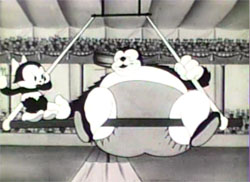 The Trapeze Artist (Charles Mintz/Columbia, Krazy Kat, 9/1/34 – Art Davis, dir., Sid Marcus, story), Following in the footsteps of the Popeye cartoon from earlier in the year discussed above, thi film is again built around an extended rendition of “The Man On the Flying Trapeze”. An incident at the circus finds the trapeze man drawing all the heart throbs of the ladies, including Krazy’s girlfriend Kitty. In an unusual seating arrangement for a big top, Krazy and Kitty appear to have a balcony box, where the trapeze swing comes perilously close to the paying customers. The trapeze man takes full advantage of the situation, tickling Kitty under the chin as he approaches on each swing – then finally lifting Kitty out of the box entirely, to accompany him above the crowd. In an odd and very deliberate continuity error, the trapeze man, who was previously facing Krazy, somehow reverses position on the trapeze seat, so that his large posterior nearly knocks Krazy out of his seat on each subsequent swing. Seeing that huge rear end in his face again and again gives Krazy an idea. Krazy grabs at a patch in the performer’s pants, opening a small hole to his fur. On the next two swings, Krazy uses a piece if chalk to draw an X on the exposed area. Then, he takes a long hat pin from Kitty’s bonnet remaining near her seat, and lines it up appropriately for the swinger’s next approach. Ouch!! But the deed doesn’t go unrecognized, and Krazy is arrested, then taken by police to a courthouse next door on assault charges.
The Trapeze Artist (Charles Mintz/Columbia, Krazy Kat, 9/1/34 – Art Davis, dir., Sid Marcus, story), Following in the footsteps of the Popeye cartoon from earlier in the year discussed above, thi film is again built around an extended rendition of “The Man On the Flying Trapeze”. An incident at the circus finds the trapeze man drawing all the heart throbs of the ladies, including Krazy’s girlfriend Kitty. In an unusual seating arrangement for a big top, Krazy and Kitty appear to have a balcony box, where the trapeze swing comes perilously close to the paying customers. The trapeze man takes full advantage of the situation, tickling Kitty under the chin as he approaches on each swing – then finally lifting Kitty out of the box entirely, to accompany him above the crowd. In an odd and very deliberate continuity error, the trapeze man, who was previously facing Krazy, somehow reverses position on the trapeze seat, so that his large posterior nearly knocks Krazy out of his seat on each subsequent swing. Seeing that huge rear end in his face again and again gives Krazy an idea. Krazy grabs at a patch in the performer’s pants, opening a small hole to his fur. On the next two swings, Krazy uses a piece if chalk to draw an X on the exposed area. Then, he takes a long hat pin from Kitty’s bonnet remaining near her seat, and lines it up appropriately for the swinger’s next approach. Ouch!! But the deed doesn’t go unrecognized, and Krazy is arrested, then taken by police to a courthouse next door on assault charges.
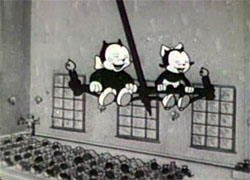 Neither prosecutor nor public defender assist in the presentation of the case before the judge, so it’s up to Krazy to plead his own case. The judge is not immediately prone to show mercy, addressing Krazy in the voice of Joe Penner with one of his catch-phrases: “Oh, you nasty man!” Krazy chooses the most traditional of defenses – the sob story – engaging in a three-verse rendition of the song referenced above, to tell how he was “betrayed by a maid in her teens” over the cad circus performer. The tactic works, as the judge draws his face closer to Krazy in a showing of sympathy – so close, that an emphatic turn by Krazy in giving his testimony places the judge’s glasses and toupee on Krazy’s face. In the jury box (consisting of only four jurors), two smaller jurors imitate the trapeze act being described, seated upon the intertwined white beards of the other two jurors. In the visitor’s gallery, a large pig weeps at the story, exhaling upon each bawl so that his pants open a gap at the waistline to catch the flood of tears, then splashing the teardrops out upon the guy in front of him on every inhale. Despite his sympathy, the judge falls asleep at one point, and Krazy (in a tactic definitely not recommended) brings him to so Krazy can finish the story by hitting the judge on the head with a mallet. A cross-gender gag which would never pass following the tightening of the production code has a line of the original song (regarding the trapeze man making the girl assume a “masculine name” to work on the trapeze) delivered by a cross-dressing female in men’s attire, ending with the standard utterance for any “gay” gag in an early cartoon – “Whooooo!”
Neither prosecutor nor public defender assist in the presentation of the case before the judge, so it’s up to Krazy to plead his own case. The judge is not immediately prone to show mercy, addressing Krazy in the voice of Joe Penner with one of his catch-phrases: “Oh, you nasty man!” Krazy chooses the most traditional of defenses – the sob story – engaging in a three-verse rendition of the song referenced above, to tell how he was “betrayed by a maid in her teens” over the cad circus performer. The tactic works, as the judge draws his face closer to Krazy in a showing of sympathy – so close, that an emphatic turn by Krazy in giving his testimony places the judge’s glasses and toupee on Krazy’s face. In the jury box (consisting of only four jurors), two smaller jurors imitate the trapeze act being described, seated upon the intertwined white beards of the other two jurors. In the visitor’s gallery, a large pig weeps at the story, exhaling upon each bawl so that his pants open a gap at the waistline to catch the flood of tears, then splashing the teardrops out upon the guy in front of him on every inhale. Despite his sympathy, the judge falls asleep at one point, and Krazy (in a tactic definitely not recommended) brings him to so Krazy can finish the story by hitting the judge on the head with a mallet. A cross-gender gag which would never pass following the tightening of the production code has a line of the original song (regarding the trapeze man making the girl assume a “masculine name” to work on the trapeze) delivered by a cross-dressing female in men’s attire, ending with the standard utterance for any “gay” gag in an early cartoon – “Whooooo!”
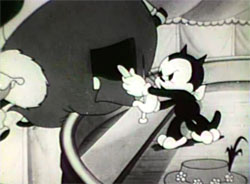 Meanwhile, back at the circus, the trapeze man starts stealing kisses from Kitty. Kitty, in fickle fashion, responds with a resounding slap across the performer’s face, knocking him from the trapeze onto a net, which bounces him through the canvas tent and straight through the roof of the court next door. Confronting Krazy in the courthouse (who greets him with the taunt, “You big sissy”), a chase begins up and down the aisles, while the judge pounds his gavel and calls for order, to no avail. The trapeze man swings at Krazy with one of the boards that broke off as he fell through the roof, as they run round and round the statue of lady Justice. The statue comes to life, loosening the handle of her sword and blowing into it like a traffic whistle, each blow calling for a reverse in direction of the chase, as Krazy briefly takes hold of the board and chases the trapeze man, then back in the other direction on the next whistle blow. Krazy spots a large pot-bellied stove providing heating for the court. He opens the grating, and scoops out with a small shovel a load of glowing coals. Holding the coals before him as a weapon, he forces the trapeze man into retreat. But Krazy trips on a fold in the carpeting of the aisle, and the coals fly off of Krazy’s shovel, landing on the end of the board carried by his opponent. Now the tables turn, and the trapeze man pursues Krazy, holding the board full of coals over Krazy’s tail, and dropping them one by one to sear Krazy’s fur. A third coal causes Krazy to leap in the air and trip again, right in the path of the trapeze man. The performer goes flying, crashing headfirst into the judge’s bench, where he is trapped. Meanwhile, the coals fly in an opposite direction (interesting defiance of the laws of momentum), and Krazy catches them again with his shovel. He is about to dump them into the trapeze man’s tights, when he realizes he can make more of the opportunity. Discarding the coals he’s got, he returns to the pot-bellied stove, obtaining a much bigger shovel, and loads up on the entire remaining coals left in the oven. His rival receives a major posterior “hotfoot”, running headlong out the courthouse door, carrying both judge and judge’s bench still stuck upon his head. Then who appears at the door but repentant Kitty, who happily reunites with Krazy. The film ends as the visitor’s gallery serenades the happy couple to the closing bars of the song, as the cats swing back and forth in trapeze fashion from the chandelier of the courtroom.
Meanwhile, back at the circus, the trapeze man starts stealing kisses from Kitty. Kitty, in fickle fashion, responds with a resounding slap across the performer’s face, knocking him from the trapeze onto a net, which bounces him through the canvas tent and straight through the roof of the court next door. Confronting Krazy in the courthouse (who greets him with the taunt, “You big sissy”), a chase begins up and down the aisles, while the judge pounds his gavel and calls for order, to no avail. The trapeze man swings at Krazy with one of the boards that broke off as he fell through the roof, as they run round and round the statue of lady Justice. The statue comes to life, loosening the handle of her sword and blowing into it like a traffic whistle, each blow calling for a reverse in direction of the chase, as Krazy briefly takes hold of the board and chases the trapeze man, then back in the other direction on the next whistle blow. Krazy spots a large pot-bellied stove providing heating for the court. He opens the grating, and scoops out with a small shovel a load of glowing coals. Holding the coals before him as a weapon, he forces the trapeze man into retreat. But Krazy trips on a fold in the carpeting of the aisle, and the coals fly off of Krazy’s shovel, landing on the end of the board carried by his opponent. Now the tables turn, and the trapeze man pursues Krazy, holding the board full of coals over Krazy’s tail, and dropping them one by one to sear Krazy’s fur. A third coal causes Krazy to leap in the air and trip again, right in the path of the trapeze man. The performer goes flying, crashing headfirst into the judge’s bench, where he is trapped. Meanwhile, the coals fly in an opposite direction (interesting defiance of the laws of momentum), and Krazy catches them again with his shovel. He is about to dump them into the trapeze man’s tights, when he realizes he can make more of the opportunity. Discarding the coals he’s got, he returns to the pot-bellied stove, obtaining a much bigger shovel, and loads up on the entire remaining coals left in the oven. His rival receives a major posterior “hotfoot”, running headlong out the courthouse door, carrying both judge and judge’s bench still stuck upon his head. Then who appears at the door but repentant Kitty, who happily reunites with Krazy. The film ends as the visitor’s gallery serenades the happy couple to the closing bars of the song, as the cats swing back and forth in trapeze fashion from the chandelier of the courtroom.
Next Time: more thirties thrills, and color comes to the big top.


 Charles Gardner is an animation enthusiast who toils by day as a member of LA Law – but by nights and weekends indulges in classic jazz and ragtime as a performer; and studies classic Hollywood cartoons… maybe a little too much.
Charles Gardner is an animation enthusiast who toils by day as a member of LA Law – but by nights and weekends indulges in classic jazz and ragtime as a performer; and studies classic Hollywood cartoons… maybe a little too much.


































































































































































Danny the lion tamer in “Just a Clown” is a late appearance of a recurring character from Paul Terry’s silent Aesop’s Film Fables cartoons. He generally played a travelling salesman, and studio publicity referred to him as “Slippery Slim”. Like Farmer Al Falfa, he also appeared contemporaneously in early Van Beuren sound cartoons like “Old Hokum Bucket”. As for how he got inside the lion costume, probably the same way he got inside the actual lion, headfirst through the mouth. Because he’s “Slippery Slim”!
One of the sideshow placards in “I Love a Parade” touts one “Jo-Jo the Dog-Faced Boy”. There really was a sideshow performer billed under that name, a Russian born with hypertrichosis or “werewolf syndrome”. P. T. Barnum brought him to America and exhibited him as a wild savage from the Russian steppes, though like most circus performers he was fluent in several languages. By the time the cartoon came out he was long dead, but his presence in the background art indicates that he was as well-remembered as his colleagues the Siamese twins and General Tom Thumb.
Will you be including the circuses of ancient Rome, as depicted in such cartoons as “Roman Punch” (Terrytoons, 1930), “Fiddlin’ Fun” (Van Beuren, 1934), “Roman Legion-Hare” (Warner Bros., 1955), and “See Ya Later Gladiator” (Warners/7 Arts, 1968)?
If we’re going to include the Roman circuses in this series, we’d definitely have to include “The Twelve Tasks of Asterix” (Dargaud Films / Studio Idefix, 1976) as well for bridging the gap between Caesar’s circuses and Ringling’s!
The glory that was Rome is for another day.
Another 1934 cartoon you could’ve included was A Royal Good Time. The Little King goes to the circus and gets chased by an Indian Magician.
https://youtu.be/mO5HCPV3z-o?si=QpGZmEB3_zzD874a
So nice to finally get the descriptive elements for the plot synopsis to “I love parade“, a cartoon that I don’t believe I’d ever seen before. I’m glad it’s on one of the Looney Tunes golden collections, however, and hopefully it will see a restoration, full and complete real soon. There will be a later treatment of circuses at MGM once the two start up the happy harmony series.
The Oyl family really got short shrift in animation. “Man on the Flying Trapeze” is indeed Nana Oyl’s only appearance; Olive’s father Cole Oyl never appears; her brother Castor Oyl (presumably) is the flutist in “The Spinach Overture,” which isn’t much of a role for the great detective who initially brought Popeye into the strip; and a niece, Diesel Oyl, is in two or three of the King Features Syndicate TV cartoons (I don’t think she was a Segar creation).
“At the Circus” is the usual English translation of the title “Misemono kembutsu” (Yokohama Cinema Shokai, Sakura Talkies, 1931 — Yasuji Murata, dir.), though a more literal translation would be “Watching the show”. Misemono was a variety of Japanese street theatre dating back to the Edo period (1603-1868). This three-minute cartoon was furnished with a soundtrack recorded on a shellac disc, to be played simultaneously with the film; however, the soundtrack has been lost, and due to the lack of intertitles the surviving film doesn’t make a whole lot of sense without it.
The cartoon begins with an establishing shot of flags and banner touting the misemono show. Cut to a balloon vendor’s stand, with some of the balloons rising into the air. A circus bareback rider rides around the ring of the big top. Then two little girls exchange some dialogue as a crowd gathers around a man wearing a cap, who is evidently a street performer of some sort. The girls begin to sing and dance in unison as the street performer nods approvingly. He speaks again, and one of the girls launches into a solo, intercut with scenes of willows on a riverbank, spinning umbrellas in the rain, a bird perched upon a bare tree, and cherry blossoms.
Then, in the film’s only really cartoony scene, the street performer cavorts wildly about. The left and right halves of his body separate and spin around before coming back together, and then his upper body and lower body likewise split apart and recombine. For good measure, he pulls his head off and tosses it around like a ball. Then it simply ends with the two girls walking away hand in hand, singing their song. Nan da yo???
First of any of these Gardner posts where I have not seen any of the ones listed!
“Bluebeard’s Brother” (Terrytoons/Educational, 12/6/32 — Frank Moser, dir.) is a bizarre cartoon, and it doesn’t make a great deal of sense, but at least it has the benefit of some compellingly grotesque animation by the great Bill Tytla. It begins with a shot of a spooky tower swarming with bats. A spider wearing an inverted funnel on his head (not the last Terrytoon character to do so) emerges from a trapdoor and recounts the tale of his wife’s murder and his subsequent trial and imprisonment. He then climbs up a long staircase and some scaffolding to the top of a rickety ladder, where he blows a trumpet call that summons the bats from the spooky tower. (Up to this point I think anyone watching the cartoon would have assumed that the spider was imprisoned inside the tower, not at some distance away from it.) He hitches a ride on the biggest of the bats, and off they all go.
Cut to a circus parade. Elephants, drum majors, jugglers, dogs, and a two-headed giraffe march merrily along, with a pretty bareback rider (a fly) and a clown (a mouse) bringing up the rear. (In a shot of the cheering crowd, the funnel-hatted spider is plainly visible scowling in the foreground, even though he’s still supposed to be flying through the air on his bat.) The crowd has filled the arena, and the bareback rider and the clown have launched into their act, when the spider arrives, leading his squadron of bats. The spectators flee in terror as the bats swoop down and carry them off one by one to some no doubt nefarious, but completely unspecified, fate. One bat grabs an elephant by its tail and hoists it up into the air, where its skin and flesh spontaneously slough off, leaving the bat with a mouthful of dangling skeleton. The elephant’s boneless remains fall to the ground, where the poor animal feebly struggles to rise to its feet. I guess that’s a joke?
One of the drum majors fires a machine gun into the sky, using the leopards’ spots as bullets. The spider sets his sights on the bareback rider and carries her away on his bat. The clown chases them by launching a rocket and riding it into the sky; it explodes at the top of its trajectory, and when the smoke clears the clown is riding through the air on the back of a unicorn, facing backwards and pulling a pair of oars. Down on the ground, the Fly Paper Squad make ready with a sheet of flypaper like firefighters with a net. The clown aims his unicorn at the spider and the girl, and CRASH! The clown and the bareback rider tumble through the air until he grabs her by the ankles and hangs below her, causing her skirt to fan out like a parachute, breaking their fall. Meanwhile, the spider falls to earth and is stuck on the sticky flypaper for the iris out. Presumably the clown and the bareback rider land safely and canoodle while the circus animals serenade them with an operatic chorus — it is a Terrytoon, after all — but we don’t actually get to see it happen.
Will you be looking at animated movies with a circus theme to them?
Movies like Dumbo, We’re Back! A Dinosaur’s Story, Madagascar 3 or Animal Crackers (2017).
One of the main things I love about THE MAN ON THE FLYING TRAPEZE is the fact that the cartoon is one of the closest to E.C. Segar’s conception of not only the characters but the setting of the THIMBLE THEATER (or POPEYE) characters: Olive Oyl’s mother Nana’s boading house, etc. Animator Gordon Sheehan told me that Segar came for a visit to see the studio around the Spring of 1934 and with that in mind, I have always wonder if THE MAN ON THE FLYING TRAPEZE was made more with Segar’s wishes in mind. Both Gordon Sheehan and Dave Tendlar remembered a few things about the making of that cartoon and because of that – and the possble E.C. Segar influence – it’s become a real favorite of mine over the years.
I’ve been reading Floyd Gottfredson’s Mickey strips lately, and one of the first arcs is about a circus. It’s an obsession, I’m afraid.
Well, if it’s an “obsession” to read Floyd Gottfredson’s MICKEY MOUSE newspaper comic strips, you could do FAR worse! The thing I liked about Gottfredson’s art and stories is that he kept Mickey and Co.’s adventurous spirit, which the animated version of “Mickey Mouse” slowly started to lose after FANTASIA in 1940.